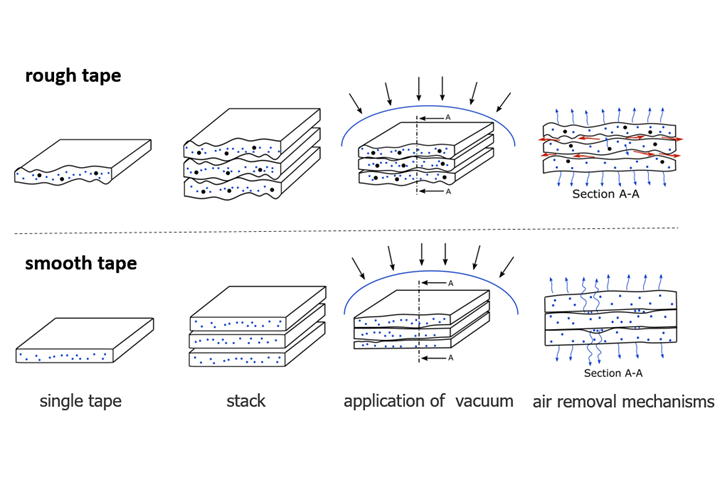TPRC investigates AFP in-situ consolidation alternative
The two-step process involves deposition of thermoplastic prepreg via AFP, followed by vacuum-bag-only (VBO). Research has already been completed in the qualitative stage.

Figure 1. Different air removal mechanisms such as in-plane permeation and through-thickness diffusion for, respectively, rough tape (top) and smooth tape (bottom). Source | TPRC
The ThermoPlastics composites Research Center (TPRC, Enschede, Netherlands), is currently investigating a two-step approach for the manufacturing of thermoplastic composite structures, involving the rapid deposition of preimpregnated thermoplastic tape, using automated fiber placement (AFP) followed by vacuum-bag-only (VBO) consolidation. Compared to the AFP with in-situ consolidation alternative, TPRC says its AFP + VBO project combines the lay-down of tape material at a cost-effective rate and an affordable post-processing step to ensure the required consolidation quality.

Figure 2. Laminates consolidated under vacuum pressure with free (left) and constrained (right) in-plane permeation; the latter was achieved by sealing off the laminate edges with tape. Source | TPRC
The main aim of the project, TPRC says, is to enable the cost-efficient out-of-autoclave (OOA) manufacture of advanced components by developing material guidelines and process models. This requires a thorough understanding of the physical mechanisms that control the OOA consolidation of fiber-placed thermoplastic laminates — for example, the in-plane permeation and diffusion of entrapped air during different stages of the consolidation process for various material configurations (Figure 1). TPRC says the mechanisms have been explored qualitatively, as seen through the effect of sealing the edges of a stack on air removal (Figure 2).
TPRC notes that the research is still ongoing, and measurement set-ups are being developed for the quantitative determination of both diffusion and permeation related material properties.
Related Content
-
Infinite Composites: Type V tanks for space, hydrogen, automotive and more
After a decade of proving its linerless, weight-saving composite tanks with NASA and more than 30 aerospace companies, this CryoSphere pioneer is scaling for growth in commercial space and sustainable transportation on Earth.
-
The potential for thermoplastic composite nacelles
Collins Aerospace draws on global team, decades of experience to demonstrate large, curved AFP and welded structures for the next generation of aircraft.
-
Recycling end-of-life composite parts: New methods, markets
From infrastructure solutions to consumer products, Polish recycler Anmet and Netherlands-based researchers are developing new methods for repurposing wind turbine blades and other composite parts.













